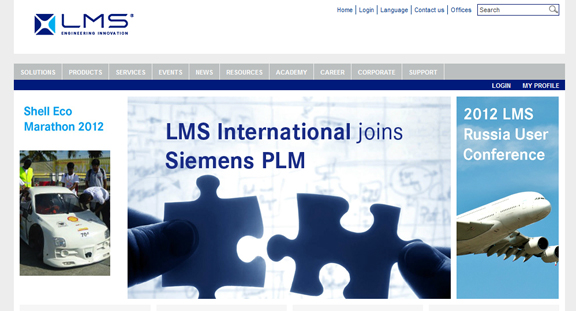Latest News
November 8, 2012
I normally work late into the night, then sleep in, but no such luxury this morning. News was breaking at 7 AM Pacific Time. Siemens PLM Software was gobbling up LMS. (To read MCAE industry veteran Dennis Nagy’s guest commentary on the acquisition, click here.)
LMS International is a household name in test and mechatronic simulation in the automotive, aerospace, and other advanced manufacturing industries. The purchase was spurred by Siemens’ desire to “provide a closed-loop systems-driven product development solution extending all the way to integrated test management,” according to the announcement.
Chuck Grindstaff, CEO and president of Siemens PLM Software, hosted a webcast from Leuven, Belgium, the site of LMS’ headquarter. “Most importantly, it’s the talent that LMS has assembled,” he said. “Worldwide, LMS’ field operation is second to none in this space. We have the best and the brightest on the subject of how to test something, how to analyze that test data, and how to simulate noise, vibrations, and harshness ...”
Siemens and its rivals in product lifecycle management (PLM) and simulation segments compete neck-to-neck in digital prototyping and virtual testing—the use of digital 3D models to simulate, troubleshoot, and optimize product design. The addition of real-world testing technologies from LMS boosts Siemens’ offerings significantly.
Siemens has a number of powerful solvers to drive virtual prototyping, but Grindstaff admitted, “What we didn’t have was a tie-in to the physical side.” The LMS acquisition is part of Siemens’ vision to “tie the virtual and the physical worlds together,” he added.
In 2006, LMS was the first company to join the software partner program of Dassault Systemes, a major rival of Siemens. The alliance gave Dassault customers, particularly those who rely on Dassault’s SIMULIA-brand simulation applications, an easier path to integrate LMS testing solutions. LMS Virtual.Lab is tightly integrated with Dassault’s CATIA V5 and SIMULIA products.
“We do have a sizable business in the [CATIA] V5 base, but it’s not the lion’s share. It’s in the 10-15% range,” revealed Urbain Vandeurzen, chairman and CEO of LMS. “We expect to continue to service that market. We have many customers who have our solutions on top of V5, and we’re fine with that. You can also imagine we’ll come up with alternative solutions.”
Those alternatives would conceivably be the NX-LMS bundles that challenge current CATIA-LMS integrations.
The acquisition serves as a wake up call (it was, for me, a literal one) to others who’re in the digital prototyping business. At some point, the predictions made in pixel-based analyses have to be confirmed or disproved in physical tests. Otherwise, simulation would be no more than educated speculation.
Subscribe to our FREE magazine, FREE email newsletters or both!
Latest News
About the Author
Kenneth Wong is Digital Engineering’s resident blogger and senior editor. Email him at [email protected] or share your thoughts on this article at digitaleng.news/facebook.
Follow DE






